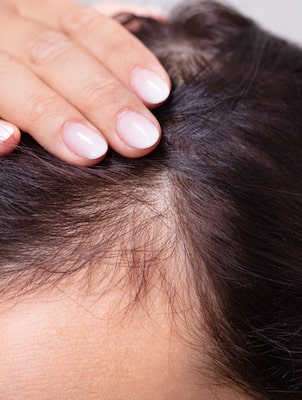Female Hair Loss – Causes and Treatment Options
Even though hair loss is often considered to be a problem for male patients, it can actually impact the hair of many female patients. There are multiple reasons women can experience hair loss and they range from medical issues to changes in their hormones to sudden stress. Let’s take a look at the issue of female hair loss and the treatment options available to patients.
Signs of Female Hair Loss
 Hair loss can start to become present on the scalp in many different ways. There might be a gradual thinning of the hair, the appearance of a bald spot or sudden hair loss all over the scalp.
Hair loss can start to become present on the scalp in many different ways. There might be a gradual thinning of the hair, the appearance of a bald spot or sudden hair loss all over the scalp.
- Bald spots can start to appear, and they generally have a look that is patchy or circular on the scalp.
- A gradual thinning of the hair on the top of the head is considered to be the most common type of hair loss for both men and women. Male patients tend to show a receding hairline while women start to notice a broader appearance to the part in their hair.
- Patients that suffer some sort of physical or emotional trauma can experience sudden hair loss where the hair quickly comes out of the scalp while combing or washing it. The appearance is normally one of overall thinning on the scalp.
- There are some instances where a full amount of hair loss can happen, and this is especially true with medical treatments such as chemotherapy.
Female-pattern baldness can also be caused by genetics and the aging process. It normally results in miniaturized hair that becomes finer in appearance, than regular hair, over time.
If the hormones are altered or disrupted thanks to medical issues like thyroid problems, the result can be hair loss on the scalp. A reduction in the production of hormones known as estrogen and progesterone can lead to stress on the body that can trigger hair loss.
The doctor examining the patient will take the symptoms the patient is experiencing into account when making a diagnosis about the cause of the hair loss. Besides a physical examination of the scalp, the doctor might decide to perform a medical test such as a scalp biopsy or a blood test.
Female Hair Loss Treatments
The type of treatment for the hair loss suffered by a female patient depends on the cause of the hair loss and the amount of the loss on the scalp.
A hair transplant can help to restore the hairline and give it a more youthful and rejuvenated look. The most popular hair transplant choice is often Follicular Unit Extraction (FUE). During FUE hair restoration surgery, the surgeon removes hair grafts on an individual basis from the donor area on the body. The individual removal of the hair grafts means there will not be a linear scar left on the body that makes it obvious to others that a hair transplant was performed. The hair grafts are then placed in premade incisions in the scalp where they will begin to grow and give the hairline a fuller and denser appearance. The results of a hair transplant are natural in appearance and will last a lifetime.
Minoxidil, which is sold under the brand name of Rogaine, is an over-the-counter medical treatment that is available in both foam and liquid forms. The medication is placed on the scalp on a daily basis so it can stimulate the growth of hair on the scalp. The use of minoxidil is a long-term commitment as the results will only last as long as the product is being used on a regular basis. If the patient stops applying minoxidil on a daily/regular basis, the gains that have been made on the scalp will eventually be lost.
While it is not used as much as in the past, hormone replacement therapy has been shown to be a treatment for androgenic alopecia. The treatment program focuses on supplying the hormone known as estrogen to the patient in order to help offset decreasing levels of the hormone in the body.
Female Hair Loss – The Next Steps
Women that are experiencing hair loss need to realize they are not alone and that it is a natural occurrence with women of all ages.
The first step is contacting a board-certified doctor who is experienced in treating the issue of female hair loss. The surgeon will study the scalp in order to determine the underlying cause of the hair loss. The doctor will also take the time to discuss the issue of hair loss with the patient and answer any questions she has about the medical condition and her available treatment options. It is also important for the doctor to discuss the hair restoration goals of the patient in order to help set realistic expectations when it comes to the final results.
Once the surgeon and the patient are on the same page about the treatment plan, the process can begin to address, and even reverse, the hair loss suffered by the patient.